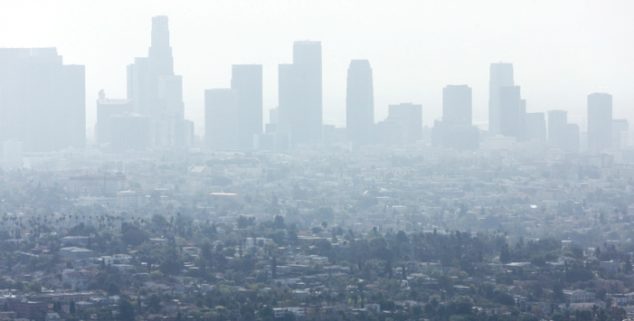News
Action needed now to meet our climate goals
 A view of Los Angeles blurred by a hazy atmosphere. (Photo: evijaf, via Shutterstock)
A view of Los Angeles blurred by a hazy atmosphere. (Photo: evijaf, via Shutterstock) For 11 years, Next 10 has been measuring economic and environmental indicators in the California Green Innovation Index. This year, the data is sobering. If the current pace of emissions decline continues, we will miss our 2030 climate targets by more than thirty years.
While California has been successful in its efforts to transform the power sector, the challenge for policymakers moving forward will be eliminating fossil fuels from harder-to-tackle sectors that depend in-part on consumer behavior.
And even here in climate-conscious California, we’re choosing larger, less-efficient vehicles.
Over the last 17 years, the industrial, residential and transportation sectors have cut their emissions by less than five percent each, and commercial emissions have grown 64 percent. Between 2020 to 2030, we will need to cut emissions that same amount—4.51 percent—economy-wide every year, compared to the average emissions reductions of only 1.57 percent that we’ve seen over the last three years we have data for (2015-17).
We need transformative change at every level.
Transportation contributes more greenhouse gas emissions than any other sector (41.1%). We know we need rapid transformation in how we travel—yet we’re buying more cars and driving more miles than ever before. Car ownership rates reached an all-time high of 80.6 vehicles per 100 people in 2018.
And even here in climate-conscious California, we’re choosing larger, less-efficient vehicles. By the fourth quarter of 2018, light-duty pickup trucks, mini-vans, and SUVs made up 57.3 percent of new vehicle registrations, up from 39.3 percent five years prior. Sales of electric vehicles are also growing—EV registrations were up 37 percent in 2017—but there’s still a gap in the marketplace for the larger electric vehicles like SUVs and pick-up trucks that consumers have come to prefer.
The 2018 California wildfires produced significantly more emissions than were reduced across the entire state’s economy the year prior.
And that’s not the only vexing transportation issue—as the economy has rebounded, emissions from air travel have gone up. We need more than electric vehicles to solve our transportation woes. We need urgent changes to where we build housing, how we structure our communities, and the availability of alternatives to air travel.
We have to focus on our housing needs in California with smart, dense, transit-oriented development closer to job centers. If not, we not only risk future economic growth, but also our ability to meet our climate targets. California is currently in the longest economic expansion on record – this is the moment for investing in the future. An economic downturn will only make innovation around solving these issues more challenging.
We must seize the current opportunity presented by our growing economy, because recent history has shown us how fragile climate success can be.
The 2018 California wildfires produced significantly more emissions than were reduced across the entire state’s economy the year prior. While our state’s forests serve a critical function in capturing carbon pollution, they can also act as an increasing source of carbon emissions. As climate change impacts take hold, it’s critical that we manage our wildfire risk to not only minimize risk to our communities, but also our climate goals.
But there are reasons for hope.
Every choice we make about how to use our land, power our homes and buildings, and travel each day makes all the difference.
California has the second-lowest rate of carbon emissions per capita in the country—dropping by 25 percent since 1990—while California’s GDP has grown more than 41 percent. We hit our 2020 target four years early due in large part to a dramatic increase in renewable electricity generation. In 2017, for the first time ever, more of California’s power mix came from renewable sources like wind and solar than from fossil fuels.
California achieved these goals with ambitious and innovative policies: constantly raising the bar and letting the market take over. Just like we’ve done over the last 30 years, we need to push the limits of what’s possible with new policies to drive transformative change. Innovation improves performance, drives down prices and creates market competition. This allows for a broader-scale adoption of groundbreaking, clean energy technologies.
We’ve seen incredible results from this virtuous cycle of innovation in both energy efficiency and renewable energy—now we need to do the same for transportation and buildings. Fossil fuels may power less electricity in California—but they still power our transportation, buildings and industrial sectors. Ultimately, every choice we make about how to use our land, power our homes and buildings, and travel each day makes all the difference.
The data in the 2019 California Green Innovation Index shows that we cannot slow the pace of our state’s historic climate action. Much success has been achieved, but we still have a long way to go. Major, transformative policy and technology breakthroughs are possible and within reach—but we must act now.
—
Editor’s Note: F. Noel Perry is a businessman and founder of Next 10, a nonprofit nonpartisan organization that educates, engages and empowers Californians to improve the state’s future. Adam Fowler is the research director at Beacon Economics and co-author of the 2019 California Green Innovation Index.
Want to see more stories like this? Sign up for The Roundup, the free daily newsletter about California politics from the editors of Capitol Weekly. Stay up to date on the news you need to know.
Sign up below, then look for a confirmation email in your inbox.

Leave a Reply